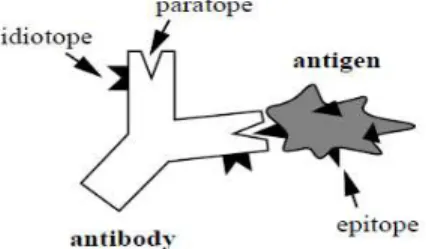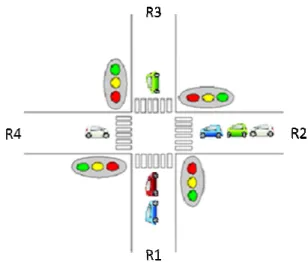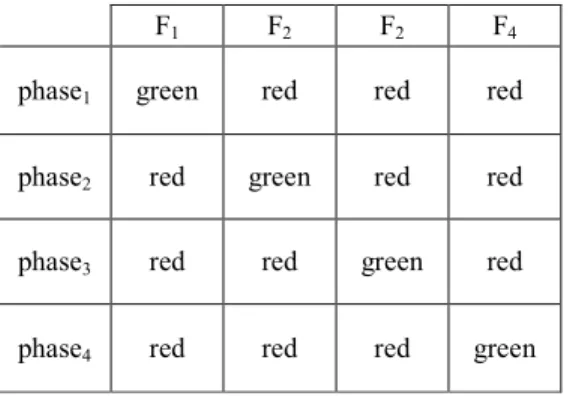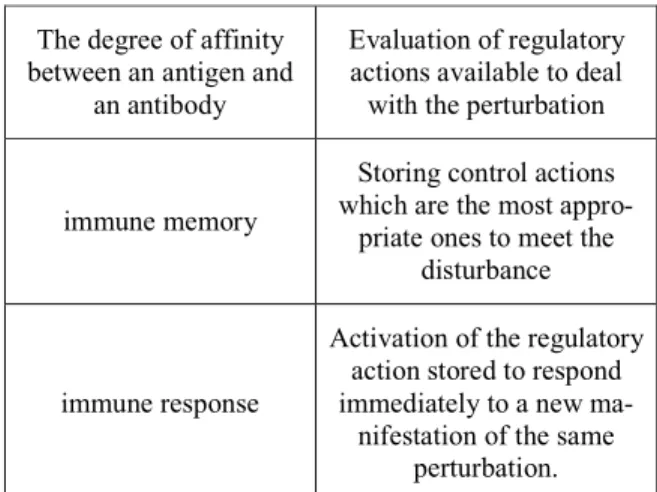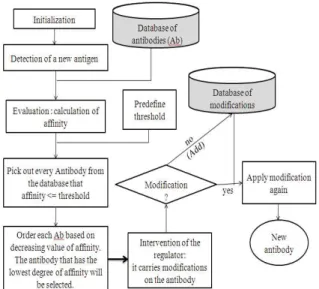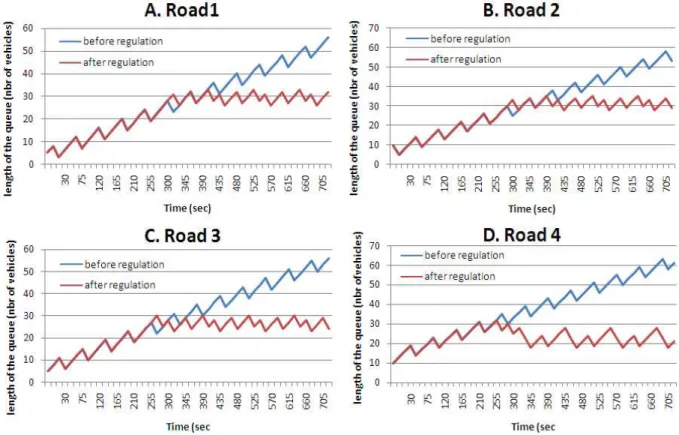HAL Id: hal-00728662
https://hal.archives-ouvertes.fr/hal-00728662
Submitted on 30 Aug 2012
HAL is a multi-disciplinary open access
archive for the deposit and dissemination of
sci-entific research documents, whether they are
pub-lished or not. The documents may come from
teaching and research institutions in France or
abroad, or from public or private research centers.
L’archive ouverte pluridisciplinaire HAL, est
destinée au dépôt et à la diffusion de documents
scientifiques de niveau recherche, publiés ou non,
émanant des établissements d’enseignement et de
recherche français ou étrangers, des laboratoires
publics ou privés.
TRAFFIC CONTROL AT INTERSECTIONS USING
ARTIFICIAL IMMUNE SYSTEM APPROACH
Boutheina Trabelsi, Sabeur Elkosantini, Sabeur Darmoul
To cite this version:
Boutheina Trabelsi, Sabeur Elkosantini, Sabeur Darmoul. TRAFFIC CONTROL AT
INTERSEC-TIONS USING ARTIFICIAL IMMUNE SYSTEM APPROACH. 9th International Conference on
Modeling, Optimization & SIMulation, Jun 2012, Bordeaux, France. �hal-00728662�
“Performance, interoperability and safety for sustainable development”
TRAFFIC CONTROL AT INTERSECTIONS USING ARTIFICIAL IMMUNE
SYSTEM APPROACH
Boutheina. TRABELSI1, Sabeur. ELKOSANTINI1,2, Saber. DARMOUL3
1
LOGIQ research group, University of Sfax - Tunisia
2
Institut Supérieur d’Informatique de Mahdia 3
Industrial Engineering Department, College of Engineering, King SAUD University Kingdom of Saudi Arabia
trabelsiboutheina@yahoo.fr, Sabeur.Elkosantini@isima.rnu.tn, sdarmoul@ksu.edu.sa
ABSTRACT: Transportation has greater importance in our daily life and plays an important role in the development
of countries and societies. Following the increasing size of cities and the number of cars, many phenomena of traffic congestion, especially at intersections are observed and generate direct and indirect costs.
Although several graphical models, artificial intelligence approaches and metaheuristics have been developed in order to improve the traffic situations at intersections, we noticed that a limited number of researches reporting the use of AIS for this case. Hence AIS is relatively a new paradigm which applies biological immune mechanisms and actors to solve world problems. We develop in this paper a methodological approach for microscopic modeling of traffic at intersec-tions using Artificial Immune System metaphors to detect and control anomalous traffic condiintersec-tions. Simulation results show the pertinence of the AIS approach.
KEYWORDS: road traffic control, intersections, biological immune system, artificial immune system.
1 INTRODUCTION
Intersection plays an important role in the road network. It is defined by the SETRA (SETRA, 1996) as an area of exchange between several roads allowing vehicles to move from one to another. The traffic in signalized inter-sections is regulated by traffic lights piloted by the con-trollers. Following the increase of the numbers of cars and of the volume of traffic flow, intersections become the bottleneck of the network and the major source of traffic congestion. Thus, it’s significant to study traffic flow at signalized intersections to relieve the congestion situations. The constructions of new infrastructure can-not be the right solution to such problem because it re-quires a large space and investments. So it it’s necessary to optimize the use of existing infrastructure by setting techniques providing traffic control actions.
Several approaches and algorithms have been developed focusing on the regulation of traffic at intersection in order to improve flow of vehicles, to minimize the laten-cy average and to guarantee the drivers safety.
The Artificial Immune System is a young emerging approach which borrows metaphors from natural im-mune system to solve world problem. This approach can operate in the field of optimization of the transport sys-tem.
The purpose of this paper is to regulate traffic at intersections equipped with traffic
lights. The potential of biological immunity is explored to inspire properties and mechanisms able to improve traffic flow and to reduce the average latency. For this case, an Artificial Immune System algorithm is pro-posed.
This paper is organized as follow: Section 2 presents the state of the art of traffic control at intersections. In sec-tion 3, an overview of biological immune system is pre-sented. Section 4 shows the application of principles of artificial immune system in order to tackle congestion situations at signalized intersections. In section 5, we conclude the work and we suggest some perspectives.
2 TRAFFIC LIGHT CONTROL: A STATE OF THE ART
The regulation of vehicle traffic flow is a complex task that has been the subject of several works in which authors are faced with several choices that depend main-ly on the type of traffic and on objectives. These choices are related to the level of detail to be adopted and to the approach which seems the most appropriate for solving the problem.
According to the level of detail, traffic models may be classified into three types: microscopic models, macros-copic models and mesosmacros-copic models.
Microscopic modeling of traffic system describes the behavior of system’s entities as well as their interactions at a high level of detail (Hoogendoorn and Bovy, 2001). A less common model is Mesoscopic one which is
lo-MOSIM’12 - June 06-08, 2012 - Bordeaux - France
cated at the intermediate level between microscopic models and macroscopic models. This approach focuses on packets of vehicles characterized by the same proper-ties which activiproper-ties and interactions are described at an average level of detail (Iodanova, 2006). The movements of packets are modeled with macroscopic rules.
Finally, the macroscopic models describe traffic in a global way with a high level of aggregation and a reduced level of detail (Buisson, 1997). In this type of study, the interactions that occur between vehicles and turbulent personal vehicles are not taken into account. When the modeler chooses the model that meets the application requirements, it will be forced to choose one or more of combined approaches allowing solving the problem.
Several regulation systems were proposed based on different approaches that aim at maximizing the flow of vehicles and minimizing the average latency.
For example, (Pappas and Mamdani, 1997) and (Liu and al., 1999) in their work have used fuzzy logic for traffic at an intersection. As for (Henn, 2001), he used fuzzy logic to model the traffic assignment and take into ac-count the effects of the dissemination of traffic informa-tion to drivers. In (Fan and Liu, 2008), a fuzzy controller is proposed to link the length of a line of vehicles ∆l and the duration of green light ∆g at an intersection.
(Bomarius, 1992) proposed a multi-agent approach in order to model the urban traffic at intersections. His model is composed of three types of agents: “vehicles”, “traffic light” (4 lights in an intersection) and “car”. These agents cooperate and communicate with each other in order to minimize the waiting time of vehicles. (Ketata, 2007) was also simulated traffic system by adopting a multi-agent approach which aims is to ensure traffic flow and find solutions for complex deadlock. Some approaches derived from biological systems have been used in this context. For example, (Ceylan and Bell, 2004) applied the genetic algorithm approach to solve traffic signal control and to optimize signal timing. (Chen et al., 2007) used the algorithm of ant colony for the development of intelligent transport and traffic con-trol at an intersection. In the work of (Wei et al., 2008), the Ant Colony approach is combined with fuzzy logic in order to control traffic lights. (Negi, 2006), as part of his thesis, applied the artificial immune system approach to optimize urban traffic problems. This new paradigm has enabled it to detect, predict and optimize the flow of traffic.
There are also various works that have used the approach of neural network whose goal is to design intelligent controller’s intersections (Pappas and Mamdani, 1997, Liu et al., 1999).
(Fan and Li, 2005, Fan, and Liu, 2008) combined fuzzy logic with the neural approach to determine the traffic light plans.
This paper tries to explain how the metaphor inspired from the biological immune system is adapted in order to tackle traffic problems at signalized intersections and to improve the situation.
3 OVERVIEW OF THE BIOLOGICAL IMMUNE SYSTEM
The biological immune system is a robust complex sys-tem. Its primary function is to protect human bodies from foreign pathogens such as viruses, bacteria, and other parasites. It is able to distinguish between items that belong to the body (self) and those that are foreign (non-self). The recognition of an antigen is provided by lymphocytes that are mainly classified into two types (T-lymphocytes and B-(T-lymphocytes). B-cells produce anti-bodies (Ab) in response to an antigen. Each B-cell can only produce one particular antibody. On the other hand, T-cells induce the B-cells to produce antibodies .Each antibody is able to identify antigens because its surface is covered with receptors called paratope. The paratope binds to a specific part of the antigen called epitope. The link between a paratope and an epitope is even stronger than their shapes which are complementary (figure1). The strength of this connection is called affinity
(Cha-bane, 2009).
Figure 1: The affinity between an antibody and an anti-gen (De Castro and Timmis, 2002)
There are two basic types of immunity that fight to pro-tect the organism: innate immune system and the adap-tive immune system. The innate immune system is an unchanging mechanism that can detect and destroy cer-tain antigens at first encounter, while the adaptive im-mune system responds to previous unknown foreign cells and builds a response to them that can remain in the overall body for a period of time.
Artificial immune systems are a relatively new area of research which constitutes intelligent methodologies inspired by biology and implementing immune mechan-isms that can be used to solve real world problems. Like any area of research not yet fully explored, it is complex to provide a complete and concise definition. However, several definitions have been proposed. For example (Dasgupta, 1998b) defined AIS as "intelligent methodol-ogies inspired by the immune system toward real-world problem solving. » Then (Timmis, 2000) defined them to be "an AIS is a computational system based upon
meta-phors of the natural immune system" The definition is provided by (de Castro and Tim in which they define AIS to be "AIS are tems, inspired by theoretical immunology immune functions, principles and models applied to problem solving."
The most important biological immune sys that are currently popular in the design rithms are negative selection, clonal select mune network model.
The negative selection, also called mechan crimination between self and non-self, process of creation of Indeed, when a T cell recognizes a self antige excluded from the population of T cells destroyed. The rest of the population is allo the thymus and circulate in the blood and do toring tasks (De Castro and Timmis, 2003). The clonal selection is a theory used to expl properties of an adaptive immune response ic stimulus. It establishes the idea that only able to recognize antigens are selected to be When the organism is exposed to an antig binds to it by producing a single type of binding with an antigen, selected B cell is produce clones of itself. In parallel, if its affi antigen is sufficiently high, it will be saved cells" (De Castro and Von Zuben, 1999). The Immune network theory, as proposed 1974, views the immune system as a regula of molecules and cells that recognize each ing a self-organizing behavior and memory absence of antigen. B-cells interact via rece mulate and suppress each other form a reg work that forms an internal image of the terns that the immune system observes ( 1986).
In order to improve the traffic situations at i AIS concepts and techniques were adapted. F reason, several analogies between biologi system and road traffic system are also made The following section shows how AIS con niques and analogies will be adapted for tr tion.
4 THE ARTIFICIAL IMMUNE SYSTE THE REGULATION OF TRAFFIC INTERSECTION
4.1 Assumptions
In this paper several assumptions will be order to simplify the development of an eff cial immune algorithm.
he most recent Timmis, 2002), adaptive and observed odels, which are system theories of AIS algo-selection and im-echanism of manages the lymphocytes. antigen, it will be and it will be allowed to leave do their moni-2003).
explain the basic to an antigen-only those cells
be proliferated. antigen, a B cell of antibody. By is stimulated to affinity with the saved as "memory posed by Jerne on regulated network other produc-emory even in the
receptors to sti-regulatory antigenic pat-(Farmer et al., at intersections, pted. For the same iological immune made.
IS concepts tech-d for traffic
regula-YSTEM FOR FIC AT AN
ill be supposed in an efficient
artifi-• In this model, the regulation a single isolated intersection unidirectional roads (figure 2) • At each corner of the road,
lights is installed compose (green, red), yellow signs dered, rather it is considered • The green light indicates a po
the intersection and a red light porary prohibition to pass. • Given the complexity of the
the multitude of modes of trans vehicles, light vehicles ...), model by assuming that traffi and that the intersection is cars. The heterogeneity of th extension of the proposed mode • On each line, vehicles pass
First in First Out way. • Cars are not allowed to make
intersection.
• There is no specific pathw heavy vehicles or bikes. • The intersection is equipped
struments of traffic measurem ure the length of the queue pneumatic hose, video sensor, • The length of the queue is cal
of cars.
• Cars are supposed having the • The speed with which a car this model is not taken into ac
Figure 2: Example of a signalized
4.2 Variables
In order to model our approach, a num must be defined:
• R: it is the whole of roads R tersection.
• i: the road number, i = {1, 2,
ation of traffic is done in ction composed of four ure 2).
road, a panel of traffic mposed of two lights will not be consi-ered as a red light.
possibility of passing light indicates a tem-the traffic system and
transport (cars, heavy ...), we simplify the traffic is homogeneous is composed only of the traffic can be an model.
pass the intersection on make half turns in the pathway for transport, pped with one of the in-asurement able to meas-queue: magnetic loop, ensor, etc.
calculated by number the same length. car crossed a road in
account.
nalized intersection
number of variables Ri that exist in an
MOSIM’12 - June 06-08, 2012 - Bordeaux - France
• R = {R1, R2, R3, R4}.
• Fi: is the light activated at the road i. This
vari-able can take two values: Fi = activated is light green the if 1 activated is light red the if 0
• Li: the length of the queue detected at the i th
road junction. This variable is expressed in number of cars.
• Lmax = const: the maximum length of a queue in
each road junction. This constant is expressed in number of cars.
• P: The period of day.
o P=1: that this is a rush hour. o P=2: that this is a normal situation. o P=3: that this is an extreme situation.
• Phase = {phase1, phase2, Phase3, Phase4} is the
switching of traffic lights. In a phase, one or more movements are allowed simultaneously in the intersection. The main role of a phase is to relieve traffic congestion while providing users with maximum security.
The different phases are shown in the following ta-ble:
F1 F2 F2 F4
phase1 green red red red
phase2 red green red red
phase3 red red green red
phase4 red red red green
Table 1: The different phases of traffic light
4.3 Analogy between the biological immune system and urban traffic system at an intersection
In order to solve the problems of traffic at intersections based on artificial immune systems, a number of analo-gies between the biological immune system and road traffic system should be established.
At the body, immune cells can be attacked by the pres-ence of antigens that disrupt normal operation. Similarly, in an urban transport system, the presence of queues at one or more roads of the intersection can attack vehicle and block the traffic. Hence, it is necessary to take an action of regulations derived from the traffic lights which eliminate perturbation and ensure the fluidity of the traffic.
Antigens may be assimilated to perturbations that pre-vent the urban traffic system and damaged cells can be seen as vehicles affected by the disturbance
.
The cells of innate immunity are able to detect the pres-ence of an antigen. In an urban traffic system, these cells could be regarded as one of the traffic measurement instruments (sensors) which are able to detect the pres-ence of a perturbation in a transport system.
B cells are able to know and fight the antigens by pro-ducing antibodies. In the context of road traffic, the antibodies may correspond to different control actions derived from the traffic lights. These B cells are able to build an immune response described by the theory of clonal selection (Darmoul et al., 2006). When the degree of affinity between an antibody of a B cell and an anti-gen exceeds a predefined threshold, the cell will be sti-mulated to divide and proliferate by producing clones of themselves.
This cell is considered to be able to recognize and elimi-nate the antigen. Then, it will be preserved in memory to deal future meetings with the same antigen or an antigen that has a structure similar to that of a known antigen. The mechanism of clonal selection could be used to respond to perturbations. When a queue is detected, B cells become activated producing different antibodies, each of them corresponds to a possible action of regula-tion. The best action is selected by evaluating the func-tion of affinity between the antibody and antigen. The function of affinity depends on the predetermined objec-tives.
The best antibodies will then be applied as an action of regulation able to respond to perturbations and will be stored in order to respond immediately to a new manife-station of the same disturbance. These analogies between the biological immune system and the road traffic system are summarized in the follow-ing table:
Biological immune
system Artificial immune system
Body Urban traffic system
The damaged cells of the body
The vehicles affected by the perturbation
Antigen Perturbation: queue
Antibody Regulatory action derived from the traffic lights
Cells of innate immunity
instruments of traffic measurement (air hoses,
electromagnetic loop, video, …)
The degree of affinity between an antigen and
an antibody
Evaluation of regulatory actions available to deal with the perturbation
immune memory
Storing control actions which are the most
appro-priate ones to meet the disturbance
immune response
Activation of the regulatory action stored to respond immediately to a new ma-nifestation of the same
perturbation. Table 2: Analogy between the biological immune system
and urban traffic system
4.4 Antibody- Antigen structure
4.4.1 Antibody
Each antibody is represented by a matrix containing the following data:
Antibody
Road number (Ri)
Length of the queue (Li)
Period of day (P) Control action
Table 3: Antigen structure
4.4.2 Antigen
Antigen must have a similar structure. Thus, it is also represented by a matrix that records the following data:
Antigen
Road number (Ri)
Length of the queue (Li)
Period of day (P)
Table 4: Antigen structure
4.4.3 Calculation of affinity between antibody and antigen
The degree of affinity calculated between an antigen and an antibody is based in this paper on the formula of
Manhattan. To calculate this affinity, several arbitrary
weights are assigned to different variables. w1 = 0.7 is
the weight of the variable Li and w2 = 0.3 is the weight of
the variable P.
The affinity is calculated as the weighted sum of abso-lute values of differences between the values of the va-riables of antigens and antibodies.
∑
∑
= ( )− ( ) +0.3 P(Ab)-P(Ag) 0.7 = degaff 4 1 i Li Ab Li Ag4.5 Artificial immune algorithm
Our algorithm contains the following steps:
• Initialization: The system starts with a normal traffic. This system consists of a set of antibo-dies which represents the random initial popula-tion and retains attenpopula-tion to perturbapopula-tions that can be achieved.
• Detection of a new antigen in the system. • Evaluation: calculation of the degree of affinity
between the antigen and the set of antibodies which exist in the initial population.
• Activation of the antibodies: antibodies that have a degree of affinity with the antigen below a given threshold of affinity will be activated. • Comparison: antibody that has the lowest
de-gree of affinity will be chosen as the specific antibody to that antigen.
• Intervention of the regulator: the regulator exer-cise mutations to the activated antibody to im-prove the affinity with the detected antigen.
o If the antibody has previously been amended by the regulator, so this regu-lation will be applied to the antibody again.
o If the regulator will create a new amendment, it will be recorded in the basic rules of change.
MOSIM’12 - June 06-08, 2012 - Bordeaux - France
Figure 3: Logical flow of the AIS algorithm for traffic regulation
4.6 Tests and results
We simulated the traffic at an intersection in three differ-ent scenarios.
4.6.1 First scenario
The intersection operates under traffic lights plan com-posed of four consecutive phases. The duration of each phase is 15 sec, during which the rate of arrival of the cars to the various roads is 3 vehicles and the output rate is 5 vehicles. The simulation was done during a rush hour (P=1) and it lasted 750 sec.
Initially, we simulated the intersection before activating the control system. So we noted that the length of the queue of vehicles in roads was increased and exceeded the maximum length (Lmax =30). So the traffic seems
blocked. This event can be explained by the fact that the total flow of incoming and outgoing of vehicles is con-stant and the phasing has remained unchanged.
To improve the situation and reduce traffic congestion, we have activated the control system in which we inte-grated control actions that respond to perturbations inhe-rent to the system. These actions act on the phases, which become dynamic. Eventually, we found a remark-able evolution of the queue of vehicles at the different roads. Figure 4 shows this evolution. The system re-sponds as soon as the length of the queue reaches or approaches the value of Lmax Therefore the length of the
queue after regulation has stabilized at around Lmax =30.
4.6.2 Second scenario
In the second scenario, we will increase the flow of ve-hicles entering the different roads of the intersection. The output rate of the vehicles, the phasing, the period of day and the maximum length Lmax remain unchanged.
Firstly, we simulated the traffic without any regulatory action. So we found that the situation was complicated. Traffic starts to be blocked from the beginning of the simulation. In fact, every 15 seconds, the total flow of vehicles entering at each road is 15 and the output rate is 5 vehicles. And as the duration of the signalization still unchanged, the queue of vehicles has increased with an accelerated manner.
We conducted a second simulation in which we inte-grated control actions. Thus, we recorded a significant decrease in the length of the queue of vehicles. After a few seconds of the simulation, this length has stabilized at around 30 cars and the problem of traffic congestion is resolved. The results of the evolution of the length of the queue of vehicles before and after the inclusion of con-trol actions are shown in Figure 5.
4.6.3 Third scenario
At the beginning of the simulation the flow rate of in-coming and outgoing vehicles, the Period of day and maximum length are identical to those of the second scenario.
At t = 375 s, an accident occurred in the conflict zone (zone of intersection of four roads). The input rate of vehicles is still unchanged (5 vehicles per 15 seconds), while the output rate decreased from 5 to 2 vehicles per 15 seconds. Therefore, the situation becomes more com-plicated and the traffic becomes blocked.
Figure 6 shows a significant change in the length of the queue after the activation of the regulator. The situation is improved and traffic seemed more fluid. At the beginning of the simulation, the length of the line of cars has stabilized at around 30 vehicles. But after the occurrence of the accident (at t = 375 sec), this length exceeded Lmax. The length of the queue after regulation
is still lower than the length before the regulation. We can thus conclude that the proposed control system was able to give satisfactory results since it has improved the situation and the traffic flow. From these three scenarios, we find that the artificial immune system is able to optimize and solve problems of traffic congestion at intersections.
Figure 4: Results of the simulation of the first scenario
MOSIM’12 - June 06-08, 2012 - Bordeaux - France
Figure 6: Results of the simulation of the third scenario
5 CONCLUSION AND PERSPECTIVES
In this paper, we proposed a strategy for urban traffic control at intersections equipped with traffic lights. This proposal is in response to situations of traffic congestion at any time of day. The purpose of the regulation is to increase the flow of vehicles and to minimize the length of the queues.
To achieve this goal, we exploited the potential of artifi-cial immune system, as it is a relatively new paradigm, to tackle traffic congestion at intersections, to maximize traffic flow and to minimize the queues. To meet these objectives, we have established an analogy between the system of urban traffic and the immune system biology. This analogy has allowed us to define the different va-riables in the model. To simplify this model, we assumed different assumptions to solve the problems of urban traffic system.
We then simulated the traffic at a single intersection in three different scenarios and we presented the results of simulations.
Our work opens new perspectives of research. Indeed, we proposed a model which focuses on traffic conges-tion at a single isolated intersecconges-tion composed of light vehicles. The heterogeneity of traffic could be taking
further into account. In addition, the modeling of traffic can be extended to more complex situations and genera-lized the model to a set of intersections. Further re-searches can also take into account driver’s behavior that can influence the flow of traffic. In the context of the artificial immune system approach, the use of other con-cepts and algorithms inspired by natural immunology as immune network theory, the theory of danger ... can be a new perspective.
REFERENCES
Bomarius, F.A., 1992. Multi-agents approach towards modeling urban traffic scenario, Tech. Rep. RR-92-47, DFKI-GmbH, Germany.
Chabane, Y., 2009. Elaboration d’un contrôleur adaptatif pour un robot mobile base sur les réseaux immunitaires artificiels.
Chen, S.W., Yang, C.B. and Peng, Y.H., 2007. Algorithms for the Traffic Light Setting Problem on the Graph Model, Proc. of the 12th Conference on Artificial Intelligence and Applications, Taiwan.
De Castro, L.N., and Timmis, J.I., 2002. Artificial immune systems: A new computational intelligence approach, Springer, Berlin, Verlag.
De Castro, L.N., and Timmis, J.I., 2003. Artificial immune system as a Novel Soft Computing paradigm, Computing laboratory, University of Kent at Canterbury , Soft Computing Journal , Vol 7.
Nationale des Sciences de l’Informatique, Université de La Manouba, Tunisie.
De Castro, L.N., and Von Zuben, F.J., 1999. Artificial immune systems, Part I – Basic theory and applications, Technical Report TR – DC.
Di Cesare, F. et al., 1994. The application of Petri nets to the Modeling, Analysis and Control of Intelligent Urban Traffic Networks, Proc. of the APN’94, Robert Valette, Zaragoza, Spain, p. 2-15.
Fan, X., and Liu, Y., 2008. Alterable-Phase Fuzzy Control Based on Neutral Network, Journal of transportation systems engineering and information technology, vol.8, n°1, p. 80−85.
Forrest, S. et al., 1994. Self non self discrimination, In Proceedings of the 1994 IEEE Symposium on Research in Security and Privacy, p 202–212. IEEE Computer Society.
Gallego, J.L., 1996. Nouvelles approches pour la commande des carrefours, thèse de doctorat, Ecole nationale supérieure de l’aéronautique et de l’espace. Henn, V., 2001. Information routière et affectation du
trafic: vers une modélisation floue, Thèse de doctorat, Université de Saint Etienne.
Hoogendoorn, S.P., and Bovy, P.H.L., 2001. State-of-the-art of Vehicular Traffic Flow Modelling, Proceedings of the I MECH E Part I Journal of Systems & Control Engineering, Vol.215, N°4, p. 283-303(21).
Iordanova, V., 2006. Contribution à la modélisation et la commande du trafic routier. Approches par bond graph et platitude, Thèse de doctorat, Université d’Artois.
Ishiguro, A., Watanabe, Y., and Kondo, T., 1997. A robot with a decentralized consensus-making mechanism based on the immune system. Proceedings of Third International Symposium on Autonomous Decentralized Systems, p 231– 237. Jerne, N. K., 1974. Towards a Network theory of the
immune system, Ann. Immunol.(Inst. Pasteur) 125C, pp. 373-389, 1974.
Jerne, Ch., Salmon, and André, R., 2009. Les anticorps , Vulgaris-Médicale.
Ketata, W., 2007. Simulation du trafic routier sur une
plate-forme agent basée sur les interactions logicielles, Mémoire de Mastère présenté à l’Ecole
Liu, Z.Y., Zhu, J., Li, X.P., et al., 1999. Multi-Phase fuzzy control of single intersection, Information and Control, 28 (6), pp. 453-458.
Negi, P., 2006. Artificial immune system based urban traffic control, Master of science, USA: Texas A&M
University.
Pappis, C., and Mamdani, E., 1997. A fuzzy logic controller for a traffic junction, IEEE Trans on Systems Man and Cybernetics, vol.7, p.707–717.
SETRA, 1995. Service d’Etude Techniques des Routes et des Autoroutes, Les capteurs du trafic routier, Guide technique.
Singh, S., and Thayer, S., 2001. Immunology directed methods for distributed robotics: A novel, im-munity-based architecture for robust control and coordination. In Proceedings of SPIE: Mobile Robots XVI, vol 4573, p 44–55, November.
Wei, Y., Han, Y. et Fan, B., 2008. Design and Simulation of Agent-Oriented Intersection, CSSE (1). P. 544-547.
